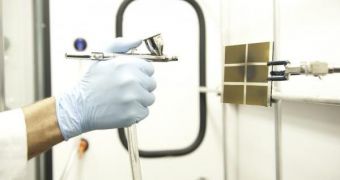Experts at the University of Texas in Austin, led by chemical engineer Brian Korgel, have recently developed a new type of solar cells, a bit less conventional. They propose that the energy-producing structures be made out of nanoparticle “inks,” which could be sprayed on rooftops and other structures like paint is from a spray gun. The inks would be just as effective as their regular counterparts, except they would be a lot cheaper, on account of the fact that the complex vacuum-chamber, gas-phase deposition process would not be required anymore, ScienceDaily reports.
“That’s essentially what’s needed to make solar-cell technology and photovoltaics widely adopted. The sun provides a nearly unlimited energy resource, but existing solar energy harvesting technologies are prohibitively expensive and cannot compete with fossil fuels,” Korgel explains. He believes that the new devices could cut costs down to about one tenth of their current level, which would make solar energy cheaper than fossil fuels altogether. He hopes that this advancement will persuade many people to go “green,” once it becomes available.
At this point, the team of UT researchers, which also includes professors Al Bard and Paul Barbara, both of the Department of Chemistry and Biochemistry, and professor Ananth Dodabalapur of the Electrical and Computer Engineering Department, has only managed to create inks that can be printed on various substrates, such as stainless steel and plastic. The experts devised a roll-to-roll printing process for the nanoparticles, which even so come out cheaper than other solar cells.
But Korgel believes that it may not be too ridiculous to imagine that, in the very near future, the inks could also be applied in the same way paint is sprayed today, from cans or other specialized instruments. “You’d have to paint the light-absorbing material and a few other layers as well. This is one step in the direction towards paintable solar cells,” the expert says. The copper indium gallium selenide (CIGS) material that the team uses for obtaining its nanoparticles is also environmentally safe, and does not produce harmful pollutants.
“CIGS has some potential advantages over silicon. It’s a direct band gap semiconductor, which means that you need much less material to make a solar cell, and that’s one of the biggest potential advantages,” Korgel concludes.

 14 DAY TRIAL //
14 DAY TRIAL //